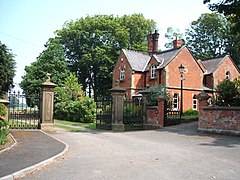Human settlement in England
| Singleton | |
|---|---|
 Singleton Park Gatehouse Singleton Park Gatehouse | |
   | |
| Population | 889 (2011 Census) |
| OS grid reference | SD380382 |
| Civil parish |
|
| District | |
| Shire county | |
| Region | |
| Country | England |
| Sovereign state | United Kingdom |
| Post town | POULTON-LE-FYLDE |
| Postcode district | FY6 |
| Dialling code | 01253 |
| Police | Lancashire |
| Fire | Lancashire |
| Ambulance | North West |
| UK Parliament | |
| |
Singleton is a village and civil parish in Lancashire, England. It is situated on the coastal plain called the Fylde. It is located south-east of Poulton-le-Fylde, and at the 2001 census had a population of 877, increasing to 889 at the 2011 Census. The parish is sometimes referred to as two parts: Great Singleton, the larger part containing the village, and Little Singleton, a small area north of the village bordering the River Wyre.
History
At the time of the Roman conquest of Britain in the 1st century AD, the area around Singleton was inhabited by a Celtic tribe called the Setantii. The village was recorded in the Domesday Book of 1086 as Singletun. The "Single" in Singleton is thought to derive from the Anglo-Saxon word "scingol" (shingle, a thin piece of wood used as a house-tile) while "tun" is the Anglo-Saxon word for a farmstead or village. Thus, Singleton would appear to mean "the tun with shingled roof(s)".
Singleton railway station once served the village as part of the Preston and Wyre Joint Railway. The station was situated west of the village, on the road to Blackpool.
Singleton Hall is a Gothic-styled mansion on Lodge Lane, built in 1855 by Thomas Miller Jr (1811–1865), son of a prominent Preston industrialist Thomas Miller Sr. The Hall was later used by Lancashire County Council as a special school for senior boys with disabilities, known as the Singleton Hall Residential Special School for Physically Handicapped Boys (Senior). The hall was largely untouched until 2004–2005, when it was extended and converted into private residences by Crosby Homes. Public pathways outside the hall have been developed and maintained by the Richard Dumbreck Singleton Trust, endowed by Richard Dumbreck, a great-nephew of Thomas Horrocks Miller. Pevsner's The Buildings of England describes the hall as "large and unlovely, in brick and stone trim with an entrance tower and a taller stair-tower. The style is domestic Gothic," and says that "1871–73 is supposed to be the date, but this may refer to extensions." He mentions "unremarkable lodges and various estate buildings," and notes that the hall, and these further buildings, have been converted to flats.
The Miller family also commissioned Singleton's parish church, St Anne's, designed by Lancaster architect Edward Graham Paley and completed in 1861. It has been designated a Grade II listed building by English Heritage.
The village has one public house, the Miller Arms, which is located in a building dating from the 17th century.
Fracking
In 2011, drilling equipment was installed at Grange Hill, east of the village, to test for shale gas in the Bowland Shale Formation around 1.2 miles (1.9 km) below the surface. In 2013, Cuadrilla and Centrica made plans for hydraulic fracturing, commonly known as fracking, at the site.
Governance
See also: Lancashire County CouncilSingleton is combined with Greenhalgh-with-Thistleton to form the ward of Singleton and Greenhalgh, which elects one councillor. As of 2008, it is represented by Maxine Chew, an independent councillor. Singleton also has a parish council.
The village is represented in the House of Commons of the Parliament of the United Kingdom as part of Fylde. It elects one Member of Parliament (MP) by the first past the post system of election. Since the 2010 general election, Fylde has been represented at Parliament by Conservative MP Mark Menzies. The village was part of the North West England constituency of the European Parliament.

See also
References
Footnotes
- Office for National Statistics : Census 2001 : Parish Headcounts : Fylde Retrieved 9 February 2010
- UK Census (2011). "Local Area Report – Singleton Parish (E04005171)". Nomis. Office for National Statistics. Retrieved 26 March 2021.
- ^ Farrer & Brownbill (1912), pp. 183–188
- Storey (2001), p. 9
- Ekwall, Eilert (1922). The Place Names of Lancashire. Manchester: Manchester University Press.
- "History of Singleton". The Richard Dumbreck Singleton Trust.
- Hartwell, Clare; Pevsner, Nikolaus (2009). "Singleton". Lancashire - North (Rev. ed.). New Haven: Yale Univ. Press. p. 613. ISBN 9780300126679.
- Hartwell & Pevsner (2009), p. 613
- "Church Of St Anne, Church Road", Heritage Gateway, English heritage, retrieved 30 October 2010
- "We've proved the haters wrong who said we've never turn around the fortunes of the Miller Arms in Singleton" – Blackpool Gazette, 2 May 2024
- Harvey, Fiona (24 September 2011). "Energy firm Cuadrilla discovers huge gas reserves under Lancashire". The Guardian. Retrieved 8 November 2013.
- Gosden, Emily (5 July 2013). "Cuadrilla and Centrica unveil two-year fracking programme". The Telegraph. Retrieved 8 November 2013.
- "The Borough of Fylde (Electoral Changes) Order 2001" (PDF). legislation.gov.uk. 3 July 2001.
- "Singleton and Greenhalgh". Fylde Borough Council. Archived from the original on 9 March 2007. Retrieved 31 December 2008.
Sources
- Farrer, William; Brownbill, J., eds. (1912), "Townships — Singleton", A History of the County of Lancaster: Volume 7, Constable, OCLC 59626695
- Hartwell, Clare; Pevsner, Nikolaus (2009) , Lancashire: North, New Haven and London: Yale University Press, ISBN 978-0-300-12667-9
- Storey, Christine (2001), Poulton-le-Fylde, Stroud: Tempus Publishing, ISBN 0-7524-2442-4
External links
 Media related to Singleton, Lancashire at Wikimedia Commons
Media related to Singleton, Lancashire at Wikimedia Commons
| Geography of the Borough of Fylde | ||
|---|---|---|
| Towns |  | |
| Villages | ||
| Parishes | ||
| Topography |
| |